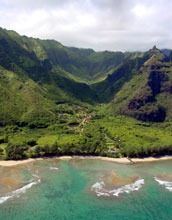Multimedia Gallery
Hawaiian EPSCoR - Limahull Ahupua'a
Hawaiian EPSCoR - Limahull Ahupua'a
The Hawaiian Ahupua'a: a "mountain-to-sea" perspective to ecosystems research. The boundaries of the Limahull Ahupua'a in North Kauai, as with most other ahupua'a, are generally aligned geographically with steep-walled valleys within which drainage streams flow to the ocean from high rainfall zones located above 4000 feet elevation in the interior of Kauai's central extinct volcano, Mt. Waialeale.
This research was conducted as part of Hawaii EPSCoR (Experimental Program to Stimulate Competitive Researcher), supported by National Science Foundation grants DPS 02-37065 and EPS 05-54657. Hawaii EPSCoR is sponsored by the National Science Foundation's EPSCoR (Experimental Program to Stimulate Competitive Research) activity. EPSCoR is a joint program between NSF and several U.S. states and territories that promotes the development of science and technology resources through partnerships between the state's research community and NSF. EPSCoR operates on the principle that aiding researchers and institutions in securing federal funding develops the state's research infrastructure and advances economic growth. EPSCoR seeks to maximize the potential inherent in the state's science and technology resources and to use those resources as a foundation for economic growth. Further information about the Hawaii EPSCoR activity is available at http://www.epscor.hawaii.edu/. (Date of Image: Sept. 6, 2002)
More about this Image
In ancient Hawaii, the "ahupua'a" were socioecological land units within which an attempt was made to temper human's impact on natural resource use with a holistic understanding of the interconnectedness between terrestrial, freshwater and marine ecosystems. These ancient land management units, therefore, encompassed a "mountain-to-sea perspective," including both the biophysical and social resources contained within which provide a convenient, traditional and holistic framework for sociological research.
Often referred to as one of the "wettest spots on earth," the extremely rugged landscape of the Hawaiian Ahupua'a presents the "worst case scenario" for deploying FR-based networks of self-powered electronic sensors that are dependent on line-of-sight transmission of data from deep in the valleys to a computer base station at the coast. Native-dominant forests in the remote interiors of valleys give way to lands dominated by humans and invasive alien species along coastlines, forming altitudinal and ecological gradients from mountain-to-sea, which have been overlaid by gradients of human disturbance over time.
Working in collaboration with the National Tropical Botanical Gardens and in partnership with the National Biocomputation Center at Stanford University and InteleSense Technologies, Inc., the Center for Conservation Research and Training at the University of Hawaii has been involved in the research and development of a sophisticated wireless environmental monitoring system which provide significant infrastructure to enhance our understanding of the socioecological systems that persist today.
Credit: Photo courtesy of the National Tropical Botanical Gardens and the Center for Conservation Research and Training, University of Hawaii
Images and other media in the National Science Foundation Multimedia Gallery are available for use in print and electronic material by NSF employees, members of the media, university staff, teachers and the general public. All media in the gallery are intended for personal, educational and nonprofit/non-commercial use only.
Images credited to the National Science Foundation, a federal agency, are in the public domain. The images were created by employees of the United States Government as part of their official duties or prepared by contractors as "works for hire" for NSF. You may freely use NSF-credited images and, at your discretion, credit NSF with a "Courtesy: National Science Foundation" notation.
Additional information about general usage can be found in Conditions.
Also Available:
Download the high-resolution JPG version of the image. (1.5 MB)
Use your mouse to right-click (Mac users may need to Ctrl-click) the link above and choose the option that will save the file or target to your computer.

